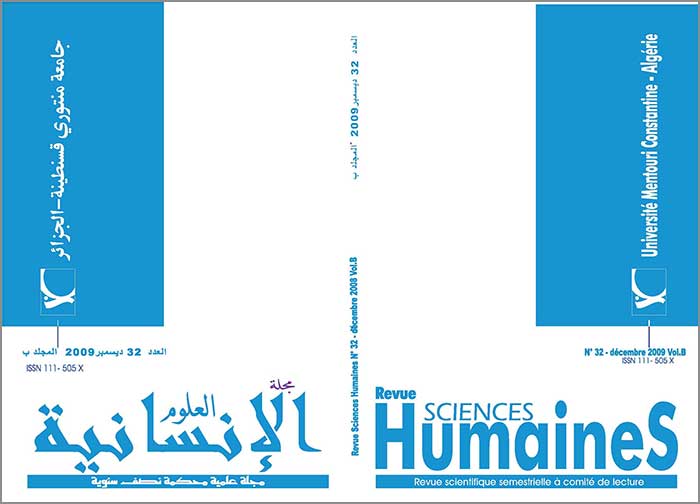Using a Portfolio as an Alternative and Authentic Tool of Assessment
Abstract
Traditional methods of testing which still prevail in our system of education mean that there is very little time for conversational English in the tests-driven in classrooms, despite of the emergence of recent advances in language testing methodology. This paper suggests to examine and understand how and why a portfolio can be used as an alternative and authentic tool of oral assessment .We believe that through this testing technique and with the investment and commitment of the pedagogical team, we will be able to develop genuine oral communication in the learners and promote a new vision of measurementDownloads
References
- Alderson, J.C. (1986). “Innovations in Language Testing?” in portal, M. (ed)
- Bachman, L. (1990). Fundamental Consideration in Language Testing, Oxford University Press.
- Bachman, L. and A.S. Palmer (1996). Language testing in practice. Oxford:
- Blanche, P. (1988). 'Self-assessment of foreign language skills: implications for teachers researchers', in RELC Journal Vol. 19. No. 1, pp.75-93.and
- Briggs, S. and C. MacDonald. (1978). A Practical Approach to Testing, Speaking and Listening Skills. Forum 16: 8-15.
- Brown, G., A. Anderson, R. Shillcock and G.Yule. (1984). Teaching Talk Strategies for Production and Assessment, Cambridge University Press.
- Brown, S. Rust, C., Gibbs, G., (1994). Strategies for Diversifying Assessment in Higher Education, Oxford, Oxford Centre for Staff Development.
- Carroll, B.J. (1980). Testing Communicative Performance, Oxford: Pergamon Press.
- Carroll, B. J., & Hall, P. J. (1985). Make your own language tests: A practical guide to writing language performance tests. Oxford: Pergamon Press
- Cohen, A.D. (2001). Second language assessment. In M. Celce-Murcia (ed.), teaching English as a second or foreign language (3rd ed., pp. 515-534). Boston: Heinle
- Davies, A. (1977). “The construction of language tests” in Allen, J.A.B. & A. Davie (Eds) The Edinburgh Course in Applied Linguistics, vol. 4: Testing and Experimental Methods, Oxford: Oxford University Press.
- Francis, J.C (1981). The reliability of two methods of marking oral tests in modern language examinations, in British Journal of Language Teaching 19, 15-23Hall, C. (1993): The direct testing of oral skills in university foreign language teaching, in IRAL 31, 23-38
- Harris, M. (1997). 'Self-assessment of language learning in formal settings' in ELT Journal Vol. 51/1, pp. 12-20. Oxford: Oxford University Press.
- Holec, H. (1988). Autonomy and self- directed learning: present fields of application Strasbourg Council of Europe.
- Hughes, R. (2002). Teaching and researching speaking. London: Pearson Education Limited.
- Ingram, D.E. (1977). Basic concepts in testing, in Allen & Davies (eds): 11-37.
- Lado, R. (1961). Language Testing: The construction and use of foreign language, London: Longman.
- LeBlanc, R. G. Painchaud (1985). “Self-Assessment as a second language placement instrument” in TESOL Quarterly, vol. 19 n° 4 Dec. 1985.
- Madsen, H. S. (1983). Techniques in testing. New York: Oxford University Press.
- McLeod, N. (1983). Some techniques for involving learners in their own evaluation, unpublished notes, British Council Language Teaching Centre, Jakarta, Indonesia.
- Messick, S.A. (1980). “Test validity and the ethics of assessment”, in American Psychologist 35: 1012-27.
- Morrow, K. (1979). “Communicative language Testing: revolution or evolution, In Brumfit, C. J. & K. Johnson (eds) The Communicative Approach to Language Teaching, Oxford: Oxford University Press.
- Nunan, D. (1996). 'Towards autonomous learning: some theoretical, empirical and practical issues' in R. Pemberton, S.L. Edward, W.W.F. Or and H.D. Pierson (Eds.): Taking Control: Autonomy in Language Learning. Hong Kong: Hong Kong University Press.
- O’Malley, J. M., and Valdez Pierce, L. (1996). Authentic assessment for English language learners: Practical approaches for teachers. New York: Addison Wesley.
- Oskarsson, M. (1989). “Self-assessment of language proficiency: rationale and applications”, in Language Testing, vol. 6 no1 June 1989 London: Edward Arnold. Oxford University Press.
- Paulson, F.L., P.R. Paulson and C.A. Meyer. (1991). what makes a portfolio? Educational Leadership.
- Rea, P.M. (1978). Assessing language as communication .MALS. Journal New series no.3.
- Robinson, P. (1973). “Oral expression tests”, in English Language Teaching, vol .25 n 1, 2-3.
- Smith, K. (1989). Self-evaluation in the Foreign Language Classroom, paper presented sat the 23rd IATEFL Conference, Warwick.
- Underhill, N. (1987). Testing spoken language. Cambridge: Cambridge University Press.
- Weir, C. J. (1995). Understanding & developing language tests. New York: Phoenix ELT.
- West, R. 1988. 'Trends in testing spoken English.' EFL Gazette. September 1988. No. 8-10.












